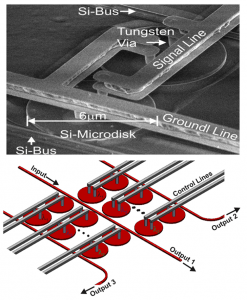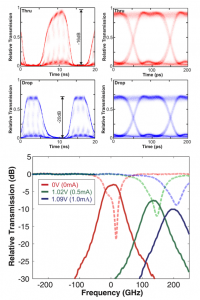Compact Modeling for Silicon Photonic Wavelength Selective Switches
- Category: Optics & Photonics
- Tags: luca daniel, yu-chung hsiao
Silicon photonic wavelength selective switches have been recently demonstrated by the Photonic Microsystems Group, led by Prof. Watts, and hold promise for alleviating communication bottlenecks in data centers and supercomputers. The dual disks of the switches (top of Figure 1), coupling lightwaves through nano-gaps, operate by applying a forward bias across the vertical p-n junction to shift the frequency band-pass between optical channels[1]. Arrays of wavelength selective switches configured into switching fabrics (bottom of Figure 1) can be used to route high-speed optical data without first converting to the electrical domain, thereby saving power, reducing complexity, and enabling scaling in port count and aggregate bandwidth substantially beyond what can be achieved with electrical communications alone.
A limiting factor for designing switching fabrics is the ability to accurately model and predict the optical and electrical behaviors of a switch network. Such large-scale simulation is made possible only when compact models faithfully capture the dynamics of all individual switches. A hybrid method consisting of both analytical and numerical modeling is proposed for achieving good accuracy. The automatic nonlinear system identification algorithm[2], proposed recently by the Computational Prototyping Group, led by Prof. Daniel, will be able to calibrate low-order analytical models against measurement for detailed nonlinearities, such as time-domain switching (top of Figure 2) and frequency-domain band-passing (bottom of Figure 2). The resulting dynamical state-space models will be physically faithful, numerically stable, and network composable. The last property will ensure that interconnected switches can be simulated in a numerical stable manner. Our proposed solution for having such guarantees will synthesize a proper constraint in the form of a sum of squares of polynomials certifying a rate bound for a storage function. In addition, the models will be parameterized in order to enable system-level optimization.
- Figure 1: Top: dual disks of switches. Bottom: switching fabrics.
- Figure 2: Top: time-domain electrical switching. Bottom: frequency-domain optical band-passing
- M. Watts, D. Trotter, and R. Young, “Maximally Confined High-Speed Second-Order Silicon Microdisk Switches,” in Optical Fiber Communication Conference/National Fiber Optic Engineers Conference, OSA Technical Digest (CD), 2008, paper PDP14. [↩]
- B. N. Bond, Z. Mahmood, Y. Li, R. Sredojevic, A. Megretski, V. Stojanovi, Y. Avniel, and L. Daniel, “Compact Modeling of Nonlinear Analog Circuits Using System Identification via Semidefinite Programming and Incremental Stability Certification,” IEEE Transactions on Computer-Aided Design of Integrated Circuits and System, vol. 29, no. 8, pp. 1149-1162, Aug. 2010. [↩]

